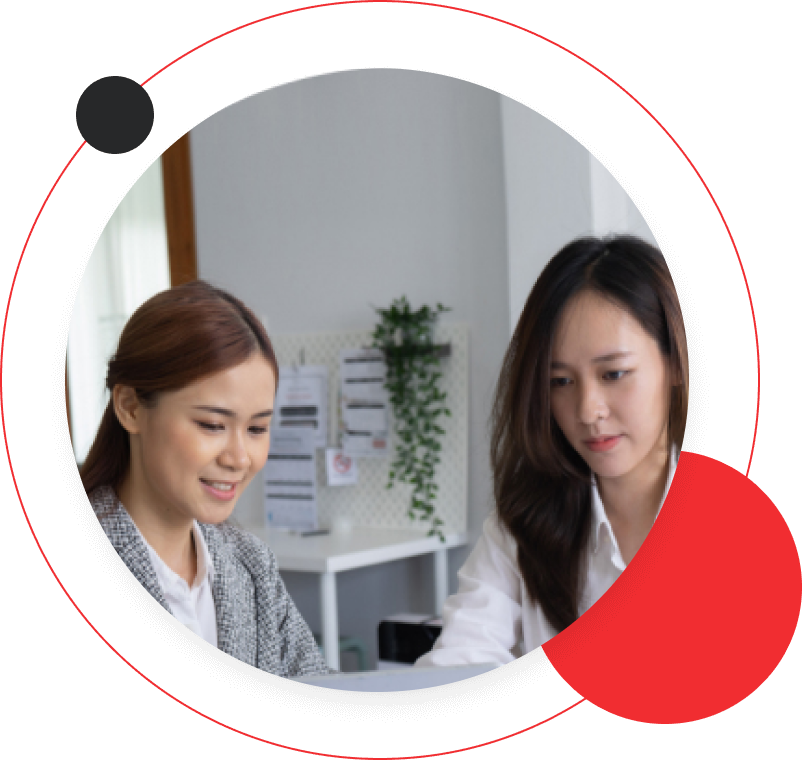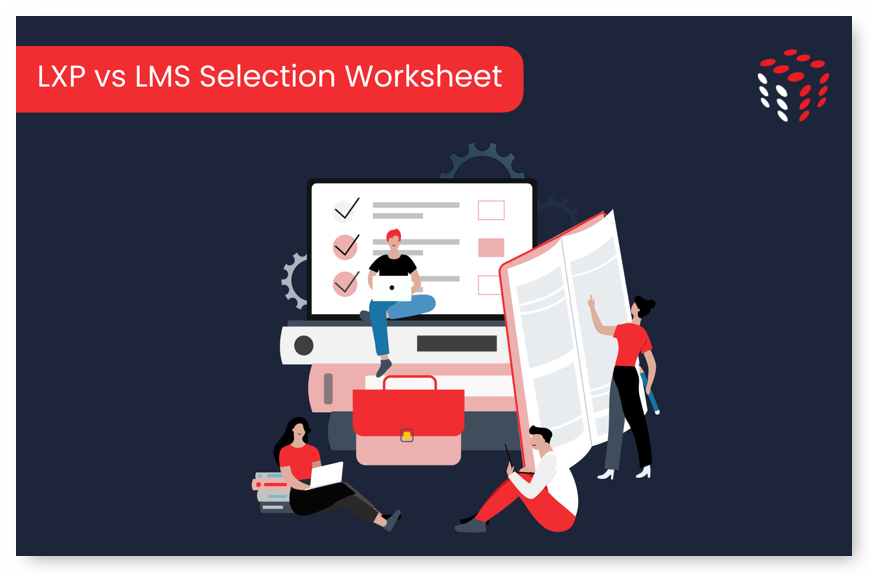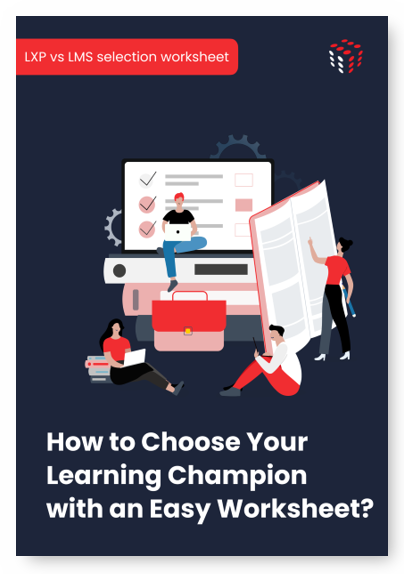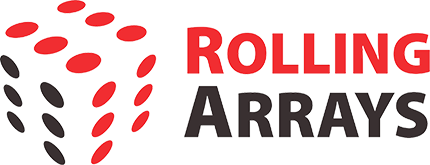
Whitepaper
Learning Management System vs Learning Experience Platform: What are the Differences?
LXP vs LMS Selection Worksheet Included


Table of Contents

LXP vs LMS Selection Worksheet
A template worksheet for organizations to fill out their needs and score LXP vs LMS options based on predefined criteria.
RESOURCES > WHITEPAPER > LXP vs LMS: What are the differences? Target audience: CHROs. Head of Learning
In a post-pandemic world, it is critical to keep remote employees engaged, productive, and well-trained. Training and professional development are essential to the employee experience. The learning management system and the learning experience platform are two software options that can help, albeit in different ways.
For many years, the only option for companies to run training and educational programmes was a Learning Management System (LMS). Because of the recent emphasis on employee experience, HR now has another option, a Learning Experience Platform (LXP). While LXP usage is increasing, most organisations still consider their LMS to be the foundation of their learning systems.
According to HR.com’s 2020 learner experience and engagement report, only 11% of companies surveyed have implemented an LXP. To understand why organisations may be hesitant to switch systems and what they should consider if they do, consider the following differences and benefits of the two systems.
What is an LMS?
LMSs provide powerful administrative tools to assist L&D teams in managing learning programmes, selecting and assigning content, and assessing learners’ progress. An LMS system delivers formal training material, such as internal policies, compliance, or new employee onboarding.
In a nutshell, a learning management system focuses primarily on compliance and tracking. Corporate learning teams can use the LMS to track and monitor employees’ progress against various competencies and standards compliance. Employees in specific roles, for example, may be required to complete specific training programmes for regulatory reasons.
On the other hand, an LMS cannot track activities outside the platform, such as informal learning discussions and online chats. The LMS is responsible for storing internal learning content, tracking learner usage, and granting permissions.
What is an LXP?
Learning experience platforms, on the other hand, allow users to access content via social media, blog posts, videos, and other channels, as well as access information from sources all over the internet. The front-end interface will resemble Netflix, while the system’s back end will generate content recommendations based on the user’s goals, experiences, preferences, and history.
In general, an LXP provides a much more personalised user experience. LXPs provide digital learning in various ways, less formal than the LMS approach, by delivering consumer-grade experiences that simplify searching and accessing content.
Many LXPs offer micro-learning, which breaks down content into small chunks to make it easier to digest. Instead of requiring employees to learn all of Microsoft Excel’s complexities, the LXP breaks it down into tasks such as creating a graph. LXPs also offer greater flexibility, allowing learners to consume information in various formats. It reflects the fact that there are numerous ways to learn.

LXP vs LMS
Choose Your Learning Champion with this Easy Worksheet
The Key Benefits:
- Cut Through the Confusion
- Data-Driven Choice
- Effortless Scorings
- Informed Decision
LXP vs LMS
The primary distinction between LXP and LMS is one of administration and control. An LMS is concerned with the administration of learning rather than the experience, whereas an LXP is concerned with the ability to facilitate personalised learning.
When comparing the two, business leaders should remember that one system does not necessarily replace the other. LXPs are a step forward in learning technology that enables organisations to move toward more interactive, personalised learning focused on the employee experience.
That is the evolution from something that simply keeps track of learning within the organisation to something that opens it up to the outside environment, focusing more on learner experience and how learners can help one another develop better experiences within the organisation. When deciding between an LXP and an LMS, organisations must consider their learning needs and company culture.
On the other hand, an LMS is more concerned with compliance and tracking than with the user experience. An LMS is a business tool that allows employers to assign training opportunities while monitoring and tracking progress toward specific competencies and standards. Its technology also enables employees to sign up for training they are required or want to take.
Each Platform Has Its Own Set of Advantages.
An LMS works best with learning content that will not change much over time, is facilitator-driven, and requires outcome measurement. The ability of an LXP to provide on-the-job training, allow learners to work on their timeline, present user-generated content or address learning goals that are constantly changing, and manage efforts that require less measurement is one of its strengths.
| LXP | LMS |
|---|---|
| Helps people learn more than just what is in the company repository. Integrates with other "non-learning" ecosystems to improve learning experiences. | Mostly serves as online course catalogues and makes it possible to track progress and report on learning performance. |
| Add to learning features like building a more comprehensive range of skills and making highly personalised, dynamic career and learning paths. | The main focus is on learning, and some modern LMSs support learning paths that can only be changed in limited ways. |
| Learning to focus on results. LXPs can use data from expanded learning interactions to determine how learning affects how well someone does their job. | Usually meets the needs of business learning (compliance). |
| The learner mainly drives a learning ecosystem that is more flexible and dynamic. Learners can add new content and choose what to read and how to read it. On these platforms, learners can also make their content. They also let you add content from other service providers, which gives you access to even more and better content. | Learning Administrators are primarily in charge. Most of what is offered is chosen and controlled by the organisation. Traditional LMS doesn't let users make and share their content. |
| LXPs are usually ecosystems open architecture. They bring together a lot of different kinds of content to make learning much more diverse. | Even when they are open to ecosystems outside the organisation, LMSs mainly act as content curators, giving learners a limited (curated) experience. |
The Emergence of Learning Experience Platforms
People primarily learn through most businesses’ Learning Management Systems.
LMSs perform their primary function: distribute training materials to all company employees.
However, enterprise training requirements have outpaced what traditional LMSs can provide. The realisation that businesses must improve their products and services to offer a better customer experience was most likely the most crucial reason for the rise of new experience-based platforms, such as those in the learning ecosystem.
Personalisation
To begin with, “traditional” LMSS were primarily used as a company’s central catalogue of digital learning assets. Users of these platforms frequently struggle to find the right piece of knowledge among the massive amounts of content.
LMS providers attempted to fill the void by adding smart searches and new ways to ask questions, but this did not address the underlying issue:
LMSs were still large libraries where you should only go when you know exactly what you need and then spend a long time looking for it. Also, it assumes that learning is done linearly when multiple channels could be considered to learn and gain the same education. Learners today want their learning process to be customised to their specific needs and desires.
Pushing the Limits of the Rules
The standards that modern LMSs use, based on SCORM, are another reason why LXPs have become popular.
SCORM, which stands for Sharable Content Object Reference Model, is a set of technical standards for eLearning software products. SCORM tells programmers how to write their code so that it can “play well” with other eLearning software. It is the de facto industry standard for eLearning interoperability.
Even though SCORM does “get results,” it can only do so much. One of the most important goals of any corporate learning platform is to link learning to performance on the job. And SCORM makes it hard to tell how practical the courses are or how learners benefit from them. Experience API (xAPI), on the other hand, is the standard that LXPs use.
xAPI is an eLearning specification that allows collecting data about the wide range of experiences a person has within online and offline training activities. xAPI’s use of a shared format for both the receiving and sending of data makes the specification an ideal tool for sharing learning between multiple systems.
It Gives the Platform a Lot More Features.
When you use xAPI, you can follow different rules while learning and doing tasks on the job. You can do that on a wide range of digital devices. This lets you track how learning affected how well an employee did their job.
With These New Rules, You can Now do Things Like
- Get information from a wide range of sources.
- Learners’ actions can be kept track of through simulations and VR sessions.
- Check how well students are taking in the course information.
- Follow where and how your workers learn (what devices they use)
- And most importantly, you can do all of this (and more!) with any device as long as it can connect directly or remotely to the LXP.
These benefits help you determine if your training works and how it affects people’s work. This makes it easier to determine your return on investment (ROI). xAPI helps you figure out what works and whether you should invest in something you wanted in the first place. It also tells you what you should invest in.
Moving Beyond “Intelligence”
Many LMS solutions are proud of how “brilliant” they are. But newer technologies for processing and analysing data have made it necessary for enterprise learning solutions to do much more than just “intelligence.”
And that is precisely what LXPs do! Now that AI technologies have come along, everything is even more interesting:
Imagine you give an AI data engine all this information about users, their actions, how well they do, and what they learn. AI turns all that into information that can be used, telling you exactly what courses your learner needs to take.
If you give it 1,000 profiles, it will “learn” to use patterns to determine each learner’s needs. This means that problems with performance can be found and fixed before they happen.
But that’s not the end of it.
AI can also be used to connect things if you connect LXP to your Human Resource Management (HRM) system, the corporate intranet, your Learning Record Store (LRS), or the enterprise Customer Relationship Management (CRM) system and collect data from all of them.
In that case, you can find many different trends and patterns. And based on these patterns, everyone can make smart decisions about training and learning. Most LMSs can’t do any of those things. Even though LMS developers are trying to get there, they still have a long way to go to make LXPs as helpful as possible. Because of this, there was an even bigger push for LXPs.
Working with a single vendor has benefits that can’t be denied. But there are also bad things about working with a single vendor. You may be familiar with the saying, “Jack of all trades, master of none.”
It can feel like an all-in-one solution has tools for every job, like a Swiss Army knife, but none of them is suitable for the job. Especially when these all-in-one companies expand their breath via acquisitions instead of organic growth negating the perceived benefits of “seamless integrations.”
Even if they grew organically, the number of resources to support each feature could vary. One can expect more headcounts (and money) behind the cash cow product and perhaps just a team of one FTE and an intern to support a brand new feature to tick the checkbox.
Deciding Which System is Best for an Organisation
When deciding between an LXP and an LMS, organisations must consider their learning needs and company culture. Because larger companies may face challenges in implementing organizational-wide change, starting with a pilot group and expanding the offering after some early publicising successes would be good.
This can make the transition easier when it comes time to select the best system. Different companies will have additional requirements and needs, but the only way to determine which platform is best is to speak with people who have implemented or at least had experience with both.
If you have an LMS that is difficult to expand or integrate and need to broaden things, maybe an LXP is what you need. Or perhaps you don’t if you have an easily expandable LMS. Because of its record-keeping capabilities, companies that need to track learning for compliance purposes, for example, may prefer an LMS over an LXP.
However, organisations are not always forced to choose between the two: Some platforms combine LXP and LMS capabilities. It may not necessarily be an either-or situation. Companies should look at both types of platforms and see how they interact.
This can make the transition easier when it comes time to select the best system. Different companies will have additional requirements and needs, but the only way to determine which platform is best is to speak with people who have implemented or at least had experience with both. If you have an LMS that is difficult to expand or integrate and need to broaden things, maybe an LXP is what you need. Or perhaps you don’t if you have an easily expandable LMS.
Because of its record-keeping capabilities, companies that need to track learning for compliance purposes, for example, may prefer an LMS over an L However, organisations are not always forced to choose between the two: Some platforms combine LXP and LMS capabilities. It may not necessarily be an either-or situation. Companies should look at both types of platforms and see how they interact.XP.
About Rolling Arrays
Rolling Arrays has been driving SAP SuccessFactors-led HR Transformation since 2009. The company specialises in SF consulting, implementation, and support and also builds applications to enhance the utility of the SuccessFactors platform. It is committed to designing systems that help its customers to attract, develop and retain talented individuals. In 2021, Rolling Arrays was recognized as one of the top 75 fastest-growing companies in Singapore by The Straits Times & Statista.



Share with your network
Get updates in your inbox